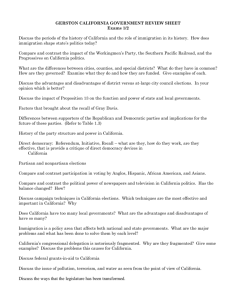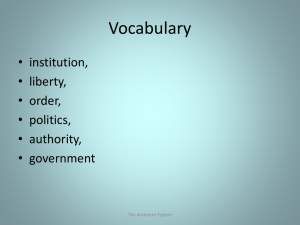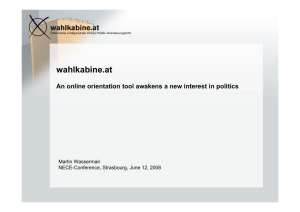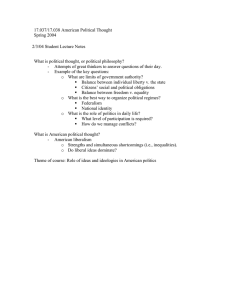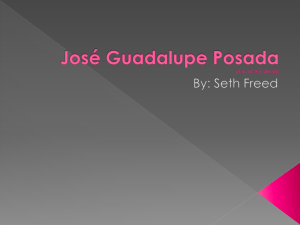The County Election
advertisement
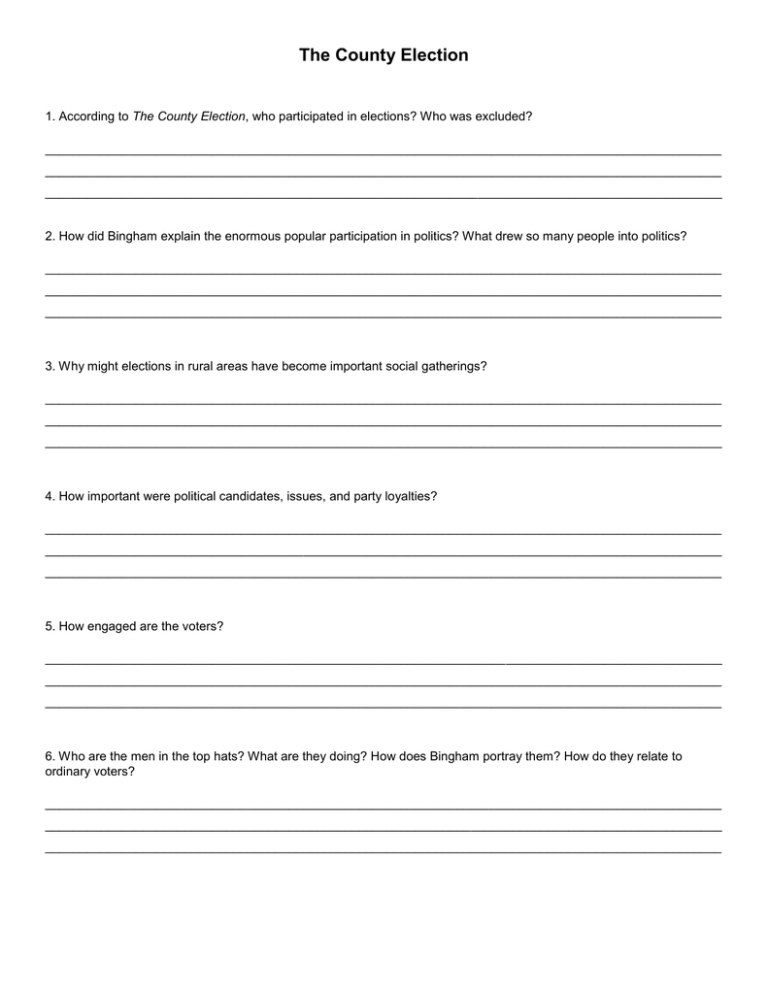
The County Election 1. According to The County Election, who participated in elections? Who was excluded? _________________________________________________________________________________________________ _________________________________________________________________________________________________ _________________________________________________________________________________________________ 2. How did Bingham explain the enormous popular participation in politics? What drew so many people into politics? _________________________________________________________________________________________________ _________________________________________________________________________________________________ _________________________________________________________________________________________________ 3. Why might elections in rural areas have become important social gatherings? _________________________________________________________________________________________________ _________________________________________________________________________________________________ _________________________________________________________________________________________________ 4. How important were political candidates, issues, and party loyalties? _________________________________________________________________________________________________ _________________________________________________________________________________________________ _________________________________________________________________________________________________ 5. How engaged are the voters? _________________________________________________________________________________________________ _________________________________________________________________________________________________ _________________________________________________________________________________________________ 6. Who are the men in the top hats? What are they doing? How does Bingham portray them? How do they relate to ordinary voters? _________________________________________________________________________________________________ _________________________________________________________________________________________________ _________________________________________________________________________________________________ 7. What do you think Bingham’s attitude toward elections was? _________________________________________________________________________________________________ _________________________________________________________________________________________________ _________________________________________________________________________________________________ 8. Did he see them as serious exercises of democracy, as farce, or as something in between? _________________________________________________________________________________________________ _________________________________________________________________________________________________ _________________________________________________________________________________________________ 9. What was his attitude toward the electorate? Did he see voters as serious well informed men or as manipulated dupes? _________________________________________________________________________________________________ _________________________________________________________________________________________________ _________________________________________________________________________________________________ 10. What does the painting say about elections in a democracy in which common people can cast ballots? _________________________________________________________________________________________________ _________________________________________________________________________________________________ _________________________________________________________________________________________________ Politics in an Oyster House 1. How does Woodville draw the viewer into the painting? _________________________________________________________________________________________________ _________________________________________________________________________________________________ _________________________________________________________________________________________________ 2. What might the open curtain symbolize? _________________________________________________________________________________________________ _________________________________________________________________________________________________ _________________________________________________________________________________________________ 3. What sort of people are the men in the painting? What do their clothes tell us? Why has Woodville dressed the young man entirely in one color? What is the significance of their difference in age? _________________________________________________________________________________________________ _________________________________________________________________________________________________ _________________________________________________________________________________________________ 4. What is the man on the right doing? How much does he care about politics? How does Woodville signal his passion? What is the source of his arguments? _________________________________________________________________________________________________ _________________________________________________________________________________________________ _________________________________________________________________________________________________ 5. How does the man on the left feel about his companion’s political arguments and passion? Do you think he agrees or disagrees? Does he care? _________________________________________________________________________________________________ _________________________________________________________________________________________________ _________________________________________________________________________________________________ 6. What attitude does Woodville take toward the political passions of the man on the right? Does he think they are good, bad, ridiculous? Compare his attitude toward the politics of his age with that of Bingham. _________________________________________________________________________________________________ _________________________________________________________________________________________________ _________________________________________________________________________________________________ 7. Compare the party man’s clothes with those of the working man. What do their clothes say about each man? _________________________________________________________________________________________________ _________________________________________________________________________________________________ _________________________________________________________________________________________________ 8. What is the politician trying to accomplish? _________________________________________________________________________________________________ _________________________________________________________________________________________________ _________________________________________________________________________________________________ 9. What function does the cartoonist think the parties and their newspapers served? _________________________________________________________________________________________________ _________________________________________________________________________________________________ _________________________________________________________________________________________________ 10. What was the cartoonist saying about the character of the Workingmen’s Party? _________________________________________________________________________________________________ _________________________________________________________________________________________________ _________________________________________________________________________________________________ 11. Which figure — the workingman or the party politician — did the cartoonist think was the legitimate protector of the accomplishments of the Revolution? _________________________________________________________________________________________________ _________________________________________________________________________________________________ _________________________________________________________________________________________________ 12. What is the cartoonist saying about the nature of politics as conducted by the major parties? _________________________________________________________________________________________________ _________________________________________________________________________________________________ _________________________________________________________________________________________________ 13. What solution does the cartoonist offer to solve the problems of political corruption and working class oppression? _________________________________________________________________________________________________ _________________________________________________________________________________________________ _________________________________________________________________________________________________ Agrarian Workingmen’s Party cartoon Captions Upper left: “We are in favour of Monarchy, Aristocracy, Monopolies, Auctions, laws that oppress the Poor, Imposture and the rights of the rich man to govern and enslave the Poor man at his will and pleasure, denying the Poor the right to redress, or any participation in political power.” Satan: “Take any, my dear Friend, they will all help you to grind the WORKIES [workingmen]!!” Box in Satan’s hand: “Ballot Box” Man in top hat: “My Old Friend, give me one of your favourites — TAMMANY — SENTINEL, or JOURNAL, or the POOR will get their rights. I’ll pay all.” Box in lower left foreground: “This contains the cause of all the misery and distress of the human family.” Upper right: “We are opposed to Monarchy, Aristocracy, Monopolies, Auctions, and in favour of the Poor to political power, denying the right of the rich to govern the Poor, and asserting in all cases, that those who labour should make the laws by which such labour should be protected and rewarded and finally, opposed to degrading the Mechanic, by making Mechanics of Felons. Our motto shall be Liberty, Equity, Justice, and The Rights of Man.” Liberty’s banner [Candidates of the Agrarian Workingmen's Party, Nov. 1830 election]: “Register, John R. Soper, Mariner. Assembly, Henry Ireland, Coppersmith; William Forbes, Silversmith; William Odell, Grocer; Micajah Handy, Shipwright; Edmund L. Livingston, Brassfounder; Joseph H. Ray, Printer; Merritt Sands, Cartman; Samuel Parsons, Moroccodresser; Thompson Town, Engineer; Alexander Ming, Senior, Printer; Hugh M’Bride, Cartman. For Lieutenant-governor, Jonas Humbert, Senior, Baker. Senator, George Bruce, Typefounder. Congress, Alden Potter, Machinist; John Tuthill, Jeweller; Thomas Skidmore, Machinist. Worker: “Now for a noble effort for Rights, Liberties, and Comforts, equal to any in the land. No more grinding the POOR — But Liberty and the Rights of man.” Box in Liberty’s hand: “Ballot Box” 1. Visual Inventory: Describe the image, beginning with the largest, most obvious features and then proceed toward more particular details. Describe fully, without making evaluations. What do you see? What is the setting? What is the time of day, the season of the year, the region of the country? __________________________________________________________________________________________ __________________________________________________________________________________________ __________________________________________________________________________________________ __________________________________________________________________________________________ __________________________________________________________________________________________ 2. Documentation: Note what you know about the work. Who made it? When? Where? What is its title? How was it made? What were the circumstances of its creation? How was it received? (With this step you may have to help students. Refer to the lesson’s background note for information.) __________________________________________________________________________________________ __________________________________________________________________________________________ __________________________________________________________________________________________ __________________________________________________________________________________________ __________________________________________________________________________________________ 3. Associations: Begin to make evaluations and draw conclusions using observations and prior knowledge. How does this image relate to its historical and cultural framework? Does it invite comparison or correlation with historical or literary texts? Do you detect a point of view or a mood conveyed by the image? Does it present any unexplained or difficult aspects? Does it trigger an emotional response in you as a viewer? What associations (historical, literary, cultural, and artistic) enrich your viewing of this image? __________________________________________________________________________________________ __________________________________________________________________________________________ __________________________________________________________________________________________ __________________________________________________________________________________________ __________________________________________________________________________________________ 4. Interpretation: Develop an interpretation of the work which both recognizes its specific features and also places it in a larger historical or thematic context. __________________________________________________________________________________________ __________________________________________________________________________________________ __________________________________________________________________________________________ __________________________________________________________________________________________ __________________________________________________________________________________________
